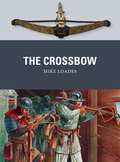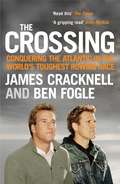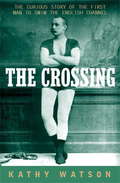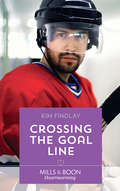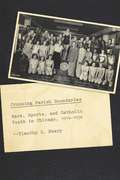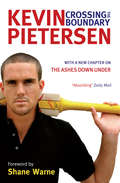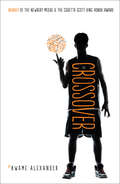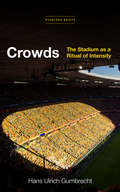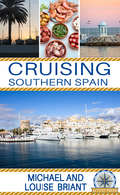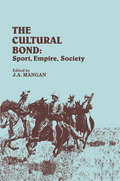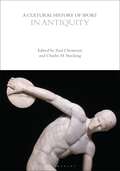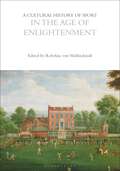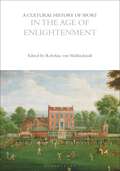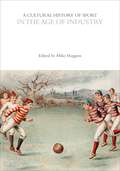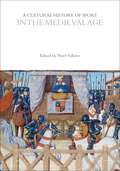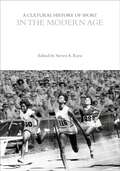- Table View
- List View
The Crossbow (Weapon Ser. #61)
by Mike LoadesTechnologically sophisticated and powerful, the crossbow has long enjoyed a popular reputation for villainous superiority because it could be used with little training as a weapon of assassination. The study of bow designs, trigger mechanisms and spanning devices reveals a tale of considerable mechanical ingenuity; advances that produced a battlefield weapon requiring comparatively little training to use. It was an extremely useful weapon, and especially effective in siege warfare for both attack and defence.Known to the Ancient Greeks and the Chinese as early as the 5th century BC, the crossbow developed both in Western Europe and in the Far East. Advances in trigger mechanisms, spanning and bow design allowed the development of ever more powerful bows. In this study acknowledged weaponry expert Mike Loades traces the origins, development, combat record and lasting legacy of the crossbow, the formidable projectile weapon that played a key role in a host of battles and sieges across Europe and Asia.
The Crossing: Conquering the Atlantic in the World's Toughest Rowing Race
by Ben Fogle James Cracknell'Read this... Two very different men fight, play games and nearly lose their lives.' The TimesWhen James Cracknell and Ben Fogle decided to compete in the Atlantic Rowing Race, they thought they knew what awaited them: nearly three thousand miles of empty ocean, stormy weather and colossal physical stress. But their epic journey would become a living hell that tested the strength of every fibre of their being. Forty nine days later James and Ben were the first pair to cross the finishing line.They had pushed themselves physically, psychologically and emotionally to the limit. They had survived without water rations, lost the few clothes they had in a freak wave, capsized, hallucinated, played games, wept, fought, grown beards, nursed blisters and rowed 2,930 miles. They will never be the same again.
The Crossing: The Curious Story Of The First Man To Swim The English Channel
by Kathy Watson*Now a Major Film*On the night of 24 August 1875 Matthew Webb, a 27-year-old British Navy captain, launched himself into the English Channel at Dover. Twenty-one hours and 45 minutes later he became the first man to swim the English Channel. In this acclaimed biography, Kathy Watson shows how Captain Webb was instrumental in bringing the sport of swimming into the modern era. It is also a study of the Victorian drive to push back the boundaries of endurance. In THE CROSSING, Watson uses this great British eccentric's extraordinary life as a springboard to explore themes of obsession and failure and the emerging force of the media, and swimming's place in our psyche.
Crossing The Goal Line: Marrying The Wedding Crasher Back To The Lake Breeze Hotel Always The Hero Crossing The Goal Line (A Hockey Romance #1)
by Kim FindlayIcebreaker or endgame? Can two devoted athletes make room in their lives for love?
Crossing Parish Boundaries: Race, Sports, and Catholic Youth in Chicago, 1914-1954 (Historical Studies of Urban America)
by Timothy B. NearyControversy erupted in spring 2001 when Chicago’s mostly white Southside Catholic Conference youth sports league rejected the application of the predominantly black St. Sabina grade school. Fifty years after Brown v. Board of Education, interracialism seemed stubbornly unattainable, and the national spotlight once again turned to the history of racial conflict in Catholic parishes. It’s widely understood that midcentury, working class, white ethnic Catholics were among the most virulent racists, but, as Crossing Parish Boundaries shows, that’s not the whole story. In this book, Timothy B. Neary reveals the history of Bishop Bernard Sheil’s Catholic Youth Organization (CYO), which brought together thousands of young people of all races and religions from Chicago’s racially segregated neighborhoods to take part in sports and educational programming. Tens of thousands of boys and girls participated in basketball, track and field, and the most popular sport of all, boxing, which regularly filled Chicago Stadium with roaring crowds. The history of Bishop Sheil and the CYO shows a cosmopolitan version of American Catholicism, one that is usually overshadowed by accounts of white ethnic Catholics aggressively resisting the racial integration of their working-class neighborhoods. By telling the story of Catholic-sponsored interracial cooperation within Chicago, Crossing Parish Boundaries complicates our understanding of northern urban race relations in the mid-twentieth century.
Crossing Parish Boundaries: Race, Sports, and Catholic Youth in Chicago, 1914-1954 (Historical Studies of Urban America)
by Timothy B. NearyControversy erupted in spring 2001 when Chicago’s mostly white Southside Catholic Conference youth sports league rejected the application of the predominantly black St. Sabina grade school. Fifty years after Brown v. Board of Education, interracialism seemed stubbornly unattainable, and the national spotlight once again turned to the history of racial conflict in Catholic parishes. It’s widely understood that midcentury, working class, white ethnic Catholics were among the most virulent racists, but, as Crossing Parish Boundaries shows, that’s not the whole story. In this book, Timothy B. Neary reveals the history of Bishop Bernard Sheil’s Catholic Youth Organization (CYO), which brought together thousands of young people of all races and religions from Chicago’s racially segregated neighborhoods to take part in sports and educational programming. Tens of thousands of boys and girls participated in basketball, track and field, and the most popular sport of all, boxing, which regularly filled Chicago Stadium with roaring crowds. The history of Bishop Sheil and the CYO shows a cosmopolitan version of American Catholicism, one that is usually overshadowed by accounts of white ethnic Catholics aggressively resisting the racial integration of their working-class neighborhoods. By telling the story of Catholic-sponsored interracial cooperation within Chicago, Crossing Parish Boundaries complicates our understanding of northern urban race relations in the mid-twentieth century.
Crossing Parish Boundaries: Race, Sports, and Catholic Youth in Chicago, 1914-1954 (Historical Studies of Urban America)
by Timothy B. NearyControversy erupted in spring 2001 when Chicago’s mostly white Southside Catholic Conference youth sports league rejected the application of the predominantly black St. Sabina grade school. Fifty years after Brown v. Board of Education, interracialism seemed stubbornly unattainable, and the national spotlight once again turned to the history of racial conflict in Catholic parishes. It’s widely understood that midcentury, working class, white ethnic Catholics were among the most virulent racists, but, as Crossing Parish Boundaries shows, that’s not the whole story. In this book, Timothy B. Neary reveals the history of Bishop Bernard Sheil’s Catholic Youth Organization (CYO), which brought together thousands of young people of all races and religions from Chicago’s racially segregated neighborhoods to take part in sports and educational programming. Tens of thousands of boys and girls participated in basketball, track and field, and the most popular sport of all, boxing, which regularly filled Chicago Stadium with roaring crowds. The history of Bishop Sheil and the CYO shows a cosmopolitan version of American Catholicism, one that is usually overshadowed by accounts of white ethnic Catholics aggressively resisting the racial integration of their working-class neighborhoods. By telling the story of Catholic-sponsored interracial cooperation within Chicago, Crossing Parish Boundaries complicates our understanding of northern urban race relations in the mid-twentieth century.
Crossing Parish Boundaries: Race, Sports, and Catholic Youth in Chicago, 1914-1954 (Historical Studies of Urban America)
by Timothy B. NearyControversy erupted in spring 2001 when Chicago’s mostly white Southside Catholic Conference youth sports league rejected the application of the predominantly black St. Sabina grade school. Fifty years after Brown v. Board of Education, interracialism seemed stubbornly unattainable, and the national spotlight once again turned to the history of racial conflict in Catholic parishes. It’s widely understood that midcentury, working class, white ethnic Catholics were among the most virulent racists, but, as Crossing Parish Boundaries shows, that’s not the whole story. In this book, Timothy B. Neary reveals the history of Bishop Bernard Sheil’s Catholic Youth Organization (CYO), which brought together thousands of young people of all races and religions from Chicago’s racially segregated neighborhoods to take part in sports and educational programming. Tens of thousands of boys and girls participated in basketball, track and field, and the most popular sport of all, boxing, which regularly filled Chicago Stadium with roaring crowds. The history of Bishop Sheil and the CYO shows a cosmopolitan version of American Catholicism, one that is usually overshadowed by accounts of white ethnic Catholics aggressively resisting the racial integration of their working-class neighborhoods. By telling the story of Catholic-sponsored interracial cooperation within Chicago, Crossing Parish Boundaries complicates our understanding of northern urban race relations in the mid-twentieth century.
Crossing Parish Boundaries: Race, Sports, and Catholic Youth in Chicago, 1914-1954 (Historical Studies of Urban America)
by Timothy B. NearyControversy erupted in spring 2001 when Chicago’s mostly white Southside Catholic Conference youth sports league rejected the application of the predominantly black St. Sabina grade school. Fifty years after Brown v. Board of Education, interracialism seemed stubbornly unattainable, and the national spotlight once again turned to the history of racial conflict in Catholic parishes. It’s widely understood that midcentury, working class, white ethnic Catholics were among the most virulent racists, but, as Crossing Parish Boundaries shows, that’s not the whole story. In this book, Timothy B. Neary reveals the history of Bishop Bernard Sheil’s Catholic Youth Organization (CYO), which brought together thousands of young people of all races and religions from Chicago’s racially segregated neighborhoods to take part in sports and educational programming. Tens of thousands of boys and girls participated in basketball, track and field, and the most popular sport of all, boxing, which regularly filled Chicago Stadium with roaring crowds. The history of Bishop Sheil and the CYO shows a cosmopolitan version of American Catholicism, one that is usually overshadowed by accounts of white ethnic Catholics aggressively resisting the racial integration of their working-class neighborhoods. By telling the story of Catholic-sponsored interracial cooperation within Chicago, Crossing Parish Boundaries complicates our understanding of northern urban race relations in the mid-twentieth century.
Crossing Parish Boundaries: Race, Sports, and Catholic Youth in Chicago, 1914-1954 (Historical Studies of Urban America)
by Timothy B. NearyControversy erupted in spring 2001 when Chicago’s mostly white Southside Catholic Conference youth sports league rejected the application of the predominantly black St. Sabina grade school. Fifty years after Brown v. Board of Education, interracialism seemed stubbornly unattainable, and the national spotlight once again turned to the history of racial conflict in Catholic parishes. It’s widely understood that midcentury, working class, white ethnic Catholics were among the most virulent racists, but, as Crossing Parish Boundaries shows, that’s not the whole story. In this book, Timothy B. Neary reveals the history of Bishop Bernard Sheil’s Catholic Youth Organization (CYO), which brought together thousands of young people of all races and religions from Chicago’s racially segregated neighborhoods to take part in sports and educational programming. Tens of thousands of boys and girls participated in basketball, track and field, and the most popular sport of all, boxing, which regularly filled Chicago Stadium with roaring crowds. The history of Bishop Sheil and the CYO shows a cosmopolitan version of American Catholicism, one that is usually overshadowed by accounts of white ethnic Catholics aggressively resisting the racial integration of their working-class neighborhoods. By telling the story of Catholic-sponsored interracial cooperation within Chicago, Crossing Parish Boundaries complicates our understanding of northern urban race relations in the mid-twentieth century.
Crossing the Boundary
by Kevin PietersenDescribed by the media as 'the David Beckham of cricket', Kevin has become the poster boy for English cricket. But he is also in possession of a prodigious talent - fearless, bold and with unflappable nerves. His unique batting style has produced hundreds of runs and many outstanding innings, culminating in his extraordinary triumph at the 2005 Ashes. Yet with the highs, come the lows, and he gives his version of events during the 2006/07 Ashes when England were defeated by Australia.Crossing the Boundary recounts Kevin's remarkable journey so far - from growing up in his native South Africa and the opposition he faced from the national cricket board; his move to England and burgeoning career at Hampshire to winning a place on the England team. It provides a rare insight into the mind of an international cricketer, on and off the pitch. Reflecting his youthful charisma and his bullish confidence, this is a sporting memoir like no other.Full of personal anecdotes and insight from numerous sporting legends such as Shane Warne, Ian Botham, and Nasser Hussain, this is the riveting story of one of the most significant cricketers of our time.
The Crossover (The Crossover Series)
by Kwame Alexander‘With a bolt of lightning on my kicks . . .The court is SIZZLING. My sweat is DRIZZLING. Stop all that quivering.Cuz tonight I'm delivering’12-year-old Josh and his twin Jordan have basketball in their blood. They’re kings of the court, star players for their school team. Their father used to be a champion player and they each want nothing more than to follow in his footsteps.Both on and off the court, there is conflict and hardship which will test Josh’s bond with his brother. In this heartfelt novel in verse, the boys find that life doesn’t come with a play-book and it's not all about winning.
Crowds: The Stadium as a Ritual of Intensity
by Hans Ulrich GumbrechtAnyone who has ever experienced a sporting event in a large stadium knows the energy that emanates from stands full of fans cheering on their teams. Although "the masses" have long held a thoroughly bad reputation in politics and culture, literary critic and avid sports fan Hans Ulrich Gumbrecht finds powerful, as yet unexplored reasons to sing the praises of crowds. Drawing on his experiences as a spectator in the stadiums of South America, Germany, and the US, Gumbrecht presents the stadium as "a ritual of intensity," thereby offering a different lens through which we might capture and even appreciate the dynamic of the masses. In presenting this alternate view, Gumbrecht enters into conversation with thinkers who were more critical of the potential of the masses, such as Gustave Le Bon, Friedrich Nietzsche, Sigmund Freud, José Ortega y Gasset, Elias Canetti, Siegfried Kracauer, T. W. Adorno, or Max Horkheimer. A preface explores college crowds as a uniquely specific phenomenon of American culture. Pairing philosophical rigor with the enthusiasm of a true fan, Gumbrecht writes from the inside and suggests that being part of a crowd opens us up to an experience beyond ourselves.
Cruising Southern Spain
by Michael BriantThe book visits the ports and marinas between Gibraltar and Port Napoleon all the way along the Costa del Sol.It has port plans, descriptions, indication of cost, and what sort of place it is.Tells you about the hazards and best routes as well as information about the area.If you come down the French Canals and are then heading for Southern Spain there is a special section on the best routes and places to stop over.With this book you do not need any other pilot books for the area on board.
The Cultural Bond: Sport, Empire, Society (Sport in the Global Society)
by J. A. ManganThe contributors to this volume examine the aspects of the cultural associations, symbolic interpretations and emotional significance of the idea of empire and, to some extent, with the post-imperial consequences. Collectively and cumulatively, their view is that sport was an important instrument of imperial cultural association and subsequent cultural change, promoting at various times and in various places imperial unity, national identity, social reform, recreational development and post-imperial goodwill.
The Cultural Bond: Sport, Empire, Society (Sport in the Global Society)
by J. A. ManganThe contributors to this volume examine the aspects of the cultural associations, symbolic interpretations and emotional significance of the idea of empire and, to some extent, with the post-imperial consequences. Collectively and cumulatively, their view is that sport was an important instrument of imperial cultural association and subsequent cultural change, promoting at various times and in various places imperial unity, national identity, social reform, recreational development and post-imperial goodwill.
A Cultural History of Sport in Antiquity (The Cultural Histories Series)
by Edited by Paul Christesen and Charles StockingA Cultural History of Sport in Antiquity covers the period 800 BCE to 600 CE. From the founding of the Olympics and Rome's celebratory games, sport permeated the cultural life of Greco-Roman antiquity almost as it does our own. Gymnasiums, public baths, monumental arenas, and circuses for chariot racing were constructed, and athletic contests proliferated. Sports-themed household objects were very popular, whilst the exploits of individual athletes, gladiators, and charioteers were immortalized in poetry, monuments, and the mosaic floors of the wealthy. This rich sporting culture attests to the importance of leisure among the middle and upper classes of the Greco-Roman world, but by 600 CE rising costs, barbarian invasions, and Christianity had swept it all away.The 6 volume set of the Cultural History of Sport presents the first comprehensive history from classical antiquity to today, covering all forms and aspects of sport and its ever-changing social, cultural, political, and economic context and impact. The themes covered in each volume are the purpose of sport; sporting time and sporting space; products, training and technology; rules and order; conflict and accommodation; inclusion, exclusion and segregation; minds, bodies and identities; representation.Paul Christesen is Professor at Dartmouth College, USA. Charles Stocking is Associate Professor at Western University, Canada.Volume 1 in the Cultural History of Sport setGeneral Editors: Wray Vamplew, Mark Dyreson, and John McClelland
A Cultural History of Sport in Antiquity (The Cultural Histories Series)
A Cultural History of Sport in Antiquity covers the period 800 BCE to 600 CE. From the founding of the Olympics and Rome's celebratory games, sport permeated the cultural life of Greco-Roman antiquity almost as it does our own. Gymnasiums, public baths, monumental arenas, and circuses for chariot racing were constructed, and athletic contests proliferated. Sports-themed household objects were very popular, whilst the exploits of individual athletes, gladiators, and charioteers were immortalized in poetry, monuments, and the mosaic floors of the wealthy. This rich sporting culture attests to the importance of leisure among the middle and upper classes of the Greco-Roman world, but by 600 CE rising costs, barbarian invasions, and Christianity had swept it all away.The 6 volume set of the Cultural History of Sport presents the first comprehensive history from classical antiquity to today, covering all forms and aspects of sport and its ever-changing social, cultural, political, and economic context and impact. The themes covered in each volume are the purpose of sport; sporting time and sporting space; products, training and technology; rules and order; conflict and accommodation; inclusion, exclusion and segregation; minds, bodies and identities; representation.Paul Christesen is Professor at Dartmouth College, USA. Charles Stocking is Associate Professor at Western University, Canada.Volume 1 in the Cultural History of Sport setGeneral Editors: Wray Vamplew, Mark Dyreson, and John McClelland
A Cultural History of Sport in the Age of Enlightenment (The Cultural Histories Series)
by Rebekka Von MallinckrodtA Cultural History of Sport in the Age of Enlightenment covers the period 1650 to 1800, a period often seen as a time of decline in sporting practice and literature. In fact, a rich sporting culture existed and sports were practised by both men and women at all levels of society. The Enlightenment called into question many of the earlier notions of religion, gender, and rank which had previously shaped sporting activities and also initiated the commercialization, professionalization and associativity which were to define modern sport. The 6 volume set of the Cultural History of Sport presents the first comprehensive history from classical antiquity to today, covering all forms and aspects of sport and its ever-changing social, cultural, political, and economic context and impact. The themes covered in each volume are the purpose of sport; sporting time and sporting space; products, training and technology; rules and order; conflict and accommodation; inclusion, exclusion and segregation; minds, bodies and identities; representation. Rebekka von Mallinckrodt is Professor at the University of Bremen, Germany. Volume 4 in the Cultural History of Sport set General Editors: Wray Vamplew, Mark Dyreson, and John McClelland
A Cultural History of Sport in the Age of Enlightenment (The Cultural Histories Series)
A Cultural History of Sport in the Age of Enlightenment covers the period 1650 to 1800, a period often seen as a time of decline in sporting practice and literature. In fact, a rich sporting culture existed and sports were practised by both men and women at all levels of society. The Enlightenment called into question many of the earlier notions of religion, gender, and rank which had previously shaped sporting activities and also initiated the commercialization, professionalization and associativity which were to define modern sport. The 6 volume set of the Cultural History of Sport presents the first comprehensive history from classical antiquity to today, covering all forms and aspects of sport and its ever-changing social, cultural, political, and economic context and impact. The themes covered in each volume are the purpose of sport; sporting time and sporting space; products, training and technology; rules and order; conflict and accommodation; inclusion, exclusion and segregation; minds, bodies and identities; representation. Rebekka von Mallinckrodt is Professor at the University of Bremen, Germany. Volume 4 in the Cultural History of Sport set General Editors: Wray Vamplew, Mark Dyreson, and John McClelland
A Cultural History of Sport in the Age of Industry (The Cultural Histories Series)
by Mike HugginsA Cultural History of Sport in the Age of Industry covers the period 1800 to 1920. Over this period, sport become increasingly global, some sports were radically altered, sports clubs proliferated, and new team games - such as baseball, basketball and the various forms of football - were created, codified, commercialized, and professionalized. Yet this was also an age of cultural and political tensions, when issues around the role of women, social class, ethnicity and race, imperial relationships, nation-building, and amateur and professional approaches were all shaping sport. At the same time, increasing urbanization, population, real wages and leisure time drove demand for sport ever higher, and the institutionalization and regulation of sport accelerated. The 6 volume set of the Cultural History of Sport presents the first comprehensive history from classical antiquity to today, covering all forms and aspects of sport and its ever-changing social, cultural, political, and economic context and impact. The themes covered in each volume are the purpose of sport; sporting time and sporting space; products, training and technology; rules and order; conflict and accommodation; inclusion, exclusion and segregation; minds, bodies and identities; representation. Mike Huggins is Emeritus Professor at the University of Cumbria, UK. Volume 5 in the Cultural History of Sport set General Editors: Wray Vamplew, Mark Dyreson, and John McClelland
A Cultural History of Sport in the Age of Industry (The Cultural Histories Series)
A Cultural History of Sport in the Age of Industry covers the period 1800 to 1920. Over this period, sport become increasingly global, some sports were radically altered, sports clubs proliferated, and new team games - such as baseball, basketball and the various forms of football - were created, codified, commercialized, and professionalized. Yet this was also an age of cultural and political tensions, when issues around the role of women, social class, ethnicity and race, imperial relationships, nation-building, and amateur and professional approaches were all shaping sport. At the same time, increasing urbanization, population, real wages and leisure time drove demand for sport ever higher, and the institutionalization and regulation of sport accelerated. The 6 volume set of the Cultural History of Sport presents the first comprehensive history from classical antiquity to today, covering all forms and aspects of sport and its ever-changing social, cultural, political, and economic context and impact. The themes covered in each volume are the purpose of sport; sporting time and sporting space; products, training and technology; rules and order; conflict and accommodation; inclusion, exclusion and segregation; minds, bodies and identities; representation. Mike Huggins is Emeritus Professor at the University of Cumbria, UK. Volume 5 in the Cultural History of Sport set General Editors: Wray Vamplew, Mark Dyreson, and John McClelland
A Cultural History of Sport in the Medieval Age (The Cultural Histories Series)
by Noel FallowsA Cultural History of Sport in the Medieval Age covers the period 600 to 1450. Lacking any viable ancient models, sport evolved into two distinct forms, divided by class. Male and female aristocrats hunted and knights engaged in jousting and tournaments, transforming increasingly outdated modes of warfare into brilliant spectacle. Meanwhile, simpler sports provided recreational distraction from the dangerously unsettled conditions of everyday life. Running, jumping, wrestling, and many ball games - soccer, cricket, baseball, golf, and tennis – had their often violent beginnings in this period. The 6 volume set of the Cultural History of Sport presents the first comprehensive history from classical antiquity to today, covering all forms and aspects of sport and its ever-changing social, cultural, political, and economic context and impact. The themes covered in each volume are the purpose of sport; sporting time and sporting space; products, training and technology; rules and order; conflict and accommodation; inclusion, exclusion and segregation; minds, bodies and identities; representation. Noel Fallows is Distinguished Research Professor at the University of Georgia, USA. Volume 2 in the Cultural History of Sport set General Editors: Wray Vamplew, Mark Dyreson, and John McClelland
A Cultural History of Sport in the Medieval Age (The Cultural Histories Series)
A Cultural History of Sport in the Medieval Age covers the period 600 to 1450. Lacking any viable ancient models, sport evolved into two distinct forms, divided by class. Male and female aristocrats hunted and knights engaged in jousting and tournaments, transforming increasingly outdated modes of warfare into brilliant spectacle. Meanwhile, simpler sports provided recreational distraction from the dangerously unsettled conditions of everyday life. Running, jumping, wrestling, and many ball games - soccer, cricket, baseball, golf, and tennis – had their often violent beginnings in this period. The 6 volume set of the Cultural History of Sport presents the first comprehensive history from classical antiquity to today, covering all forms and aspects of sport and its ever-changing social, cultural, political, and economic context and impact. The themes covered in each volume are the purpose of sport; sporting time and sporting space; products, training and technology; rules and order; conflict and accommodation; inclusion, exclusion and segregation; minds, bodies and identities; representation. Noel Fallows is Distinguished Research Professor at the University of Georgia, USA. Volume 2 in the Cultural History of Sport set General Editors: Wray Vamplew, Mark Dyreson, and John McClelland
A Cultural History of Sport in the Modern Age (The Cultural Histories Series)
by Edited by Steven A. RiessA Cultural History of Sport in the Modern Age covers the period 1920 to today. Over this time, world-wide participation in sport has been shaped by economic developments, communication and transportation innovations, declining racism, diplomacy, political ideologies, feminization, democratization, as well as increasing professionalization and commercialization. Sport has now become both a global cultural force and one of the deepest ways in which individual nations express their myths, beliefs, values, traditions and realities. The 6 volume set of the Cultural History of Sport presents the first comprehensive history from classical antiquity to today, covering all forms and aspects of sport and its ever-changing social, cultural, political, and economic context and impact. The themes covered in each volume are the purpose of sport; sporting time and sporting space; products, training and technology; rules and order; conflict and accommodation; inclusion, exclusion and segregation; minds, bodies and identities; representation. Steven A. Riess is Professor Emeritus at Northeastern Illinois University, USA. Volume 6 in the Cultural History of Sport set General Editors: Wray Vamplew, Mark Dyreson, and John McClelland
